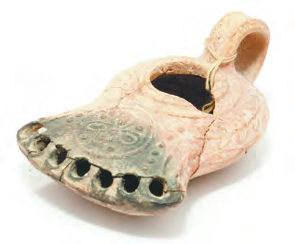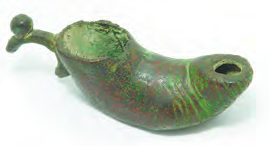Article
ANCIENT ILLUMINATION
Paul Rosenberg
Moorabool Antique Gallery
Lights are taken for granted with a flick of a modern switch. Backtracking, a few millennia ago if you needed light after the sun set, you had to plan and organize it yourself.

Only now are we recognising the value of renewable energy – something ancient cultures had already worked out. The most desirable light fuel was whale oil that burned true and almost odourless, yet this was a scarce resource and thus expensive. Fish oil would smell a little more. Very primitive lamps burned animal fat, a very smelly option.
The most common fuel in the Roman Empire was vegetable oil, such as olive oil that is still readily available today. So one evening, I burned olive oil in a reproduction lamp. The light frwom the flame was sufficient to read by at close quarters. The faint odour was similar to cooking with olive oil. The small lamp was comparable with small Roman terracotta lamps and it burned for around four hours on a single fill.
Essential to oil lamps were the pottery vessels holding and transporting oils. They ranged in size from large amphora in the Roman period to small flasks for purchasing a few days’ supply. Another antiquity associated with oil lamps was a filler that held oil in a reserve with a long spout to fill a lamp.
ANCIENT LAMPS
One of the earliest known oil lamps was found in the Lascaux caves in France. It is a large round bowl in which a wick could be floated with a long handle. It was most probably left by an artist responsible for the remarkable wall paintings, over 17,000 years ago.
Other Neolithic lamps were simple dished rocks that probably burned animal fat. In ancient Mesopotamia, clam shells were valued and their natural form provided multiple mouths to support wicks. Sumerian 4,500 years old luxury lamps were carved from alabaster to resemble shells.
An innovation during the BronzeAge in the Middle East was the potter’s wheel. One of the earliest results of this new technology was the lamp – simple bowls thrown on the wheel, with a pinched spout to take a wick. This clever design provided a flat base for stability – essential when using fire in a flammable hut!
An Indus culture lamp, 5,000 years old, has four spouts pinched into the sides, quadrupling the amount of light fromone vessel. Gradually the bowl became deeper to hold more fuel, with the spout more enclosed to protect the longer-burning wick.
By the Iron Age, 3,000- 2,500 years ago, the lamp became more enclosed and the spout for the wick protruded. Greek potters perfected the lamp form around 2,600 years ago, superbly shaped with fine burnished or glazed surfaces and elegant forms.
INTRODUCTION OF THE MOULD
The Greek innovation around 2,400 years ago of the mould changed lamp production dramatically, as a vessel could be pressed into a two-piece mould very quickly and cheaply. Potters then looked to decorating these wares. The Romans for example decorated their lamps’ spout and the flat top surface– known as the discus – with patterns, often
geometric or incorporated natural forms such as leaves. The discus could support a scene of popular subjects including hunters attacking animals, gladiators, wine pots and animals.
Rare examples from this period are modelled rather than moulded, such as the boot lamp, the wick coming out of the big toe, held in the Rosenberg Collection.
The excavation of Pompeii in the 18th century revealed some amazing lamps in their original context. Large floor stands held multiple vessels, such as a table stand in the form of a tree, from which hung two bronze lamps with double spouts. The Rosenberg Collection has a 200 year old copy of the original 2,000 year old light stand.
Another lamp is shaped like an elephant, a driver and a castellation on its back, and the wick hole is in the tip of the trunk! This probably represented Hannibal (247-183 BCE), the Carthaginian commander who brought armoured elephants to battle the Romans. This example was made around the first century CE.
RITUAL & RELIGIOUS USE
Lamps were of great ritual importance to a range of religions, and religious symbols are often found on lamps.
Of early Christian origins is the Chi Rho symbol, representing the Greek word for Christ. Early Christians hid it beneath the lamp as a secret sign while later, as Christianity becomes accepted, it makes its appearance on the top. Other lamps of the same period were made for the Jewish market, and are moulded with the seven branch candlestick, while another rare example has seven spouts representing the Menorah.
During the so-called Dark Ages in Europe, lamps were once again simple pottery vessels. In contrast, Middle Eastern lamps of the time had beautiful glazes and forms. There were tall animal-like forms and long spouted forms. Simple unglazed lamps from the 10th to 14th centuries had distinctive geometric patterns in bands around the vessels.
Candles became the preferred illumination in Europe. The discovery of kerosene (from coal) in the 1850s brought in the kero lamp revolution in the Victorian era.
Lamps are a wonderful item to collect with a direct link to ancient times.Made by the millions, they begin selling at less than $100 for a piece of history you can hold in your palm.



AAADA Antiques & Art Fair Sydney
1-3 September 2023
The Great Hall – University of Sydney
aaada.org.au/sydney
Tickets on sale now SYDNEY
Buy your tickets online for a chance to WIN $1,000 to spend at the AAADA Antiques & Art Fair Sydney and a AAADA representative will take you around the fair providing you with guidance as you browse. All admission tickets purchased to either fair online are automatically entered for their corresponding location. For eligibility check our T&Cs on our website. Entries for Sydney close 5pm on the 29th of August 2023 (AEST).
AAADA 2023 ANTIQUES & ART FAIR MELBOURNE CATALOGUE OUT NOW
CLICK HERE
Click for a full list of our dealers, service providers & Decorative Arts & Collectors Societies
Australian Antique & Art Dealers Association
info@aaada.org.au
+61 498 059 661
Facebook
Instagram